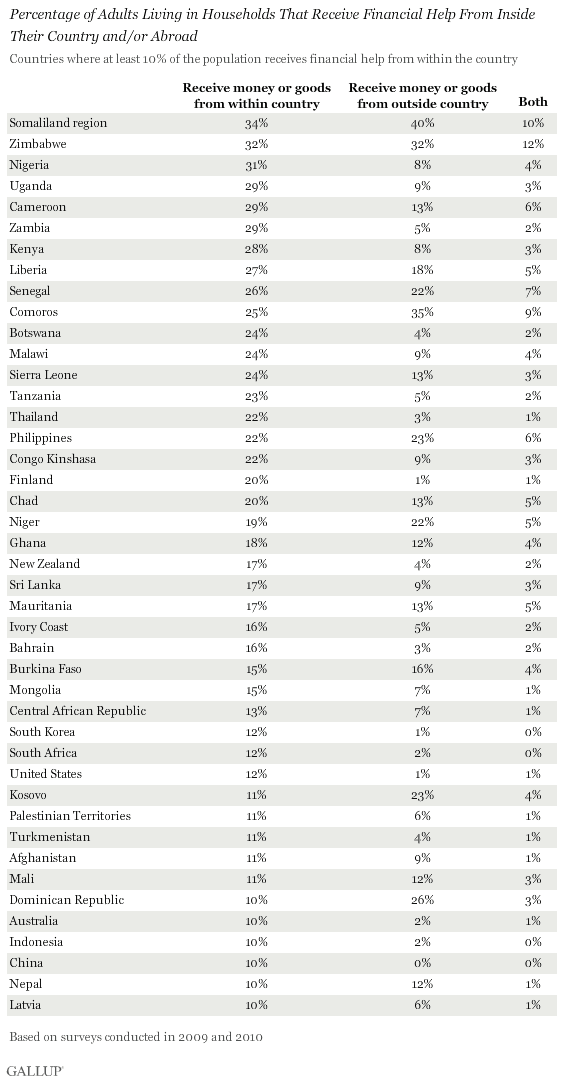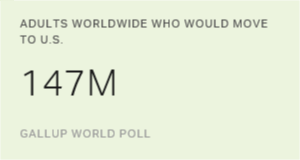WASHINGTON, D.C. -- While international remittances dominate the global dialogue about migration and development, they are only part of the conversation. Gallup's surveys in 135 countries between 2009 and 2010 reveal households worldwide are three times more likely get financial help from individuals within the same country (9%) than from outside the country (3%).

Ten percent or more of the adult population in 43 countries report that their household in the past year received help -- in the form of money or goods -- from another individual living inside their country. More than half of these countries are concentrated in sub-Saharan Africa, which also has the highest prevalence of adults receiving international remittances. In the Somaliland region, Zimbabwe, Uganda, Cameroon, Zambia, Kenya, Liberia, and Senegal, more than one in four adults live in households that receive help from individuals in the same country.
There is also a large cluster of countries in developing Asia where 10% or more of the population receives financial help from within the country: Thailand (22%), Philippines (22%), Sri Lanka (17%), Mongolia (15%), Indonesia (10%), China (10%), and Nepal (10%).

While more common in developing countries, adults in developed countries also report receiving financial help from others in the same country. At least 1 in 10 residents in developed countries such as Finland (20%), New Zealand (17%), South Korea (12%), the United States (12%), and Australia (10%) say their household gets this type of assistance. Sizable percentages in Canada (9%), Germany (9%), and Hong Kong (9%) report this too.
Households Typically Don't Get Both International Remittances and Internal Help
Households worldwide tend to receive one type of financial help or the other, and in rare instances, they receive both types of assistance. For example, in the Philippines, 22% of adults say their households receive financial help from within the country, and 23% receive international remittances, but 6% receive both.
In the Somaliland region, Zimbabwe, Senegal, and Comoros, households significantly rely on both types of financial help. Others, such as residents in Nigeria, Uganda, and Thailand rely primarily on help from within the country.
Bottom Line
Measuring international remittances and the financial help that households receive from individuals in their own countries is vital not only because they represent lifelines for millions worldwide, but also because they are a useful tool for development. Studying each provides a more complete picture of the structure of remittances worldwide and hints at their true size.
Julie Ray contributed to this report.
For complete data sets or custom research from the more than 150 countries Gallup continually surveys, please contact SocialandEconomicAnalysis@gallup.com or call 202.715.3030.
Survey Methods
Results are based on face-to-face and telephone interviews conducted in 2009 and 2010 among residents aged 15 and older in 135 countries. Data are aggregated. For most countries, sample size is 2,000 adults or greater. Four countries have sample sizes between 500 and 1,000: New Zealand, Latvia, Haiti, and Estonia. Data for Gulf Cooperation Council countries exclude non-Arab expatriates. For results based on the total sample in each country, one can say with 95% confidence that the maximum margin of sampling error ranges from ±1.0 percentage point to ±4.7 percentage points. The margin of error reflects the influence of data weighting. In addition to sampling error, question wording and practical difficulties in conducting surveys can introduce error or bias into the findings of public opinion polls.
For more complete methodology and specific survey dates, please review Gallup's Country Data Set details.
